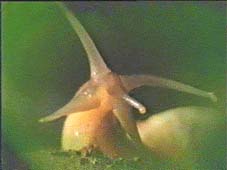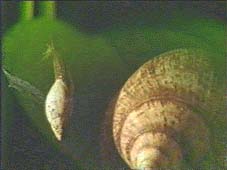


Achauna fulicia reached Tahiti by 1967 and soon spread to the Island of Moorea by the mid-1970's with particular devastating effects. There is one account of a farmer that removed two wheel-barrow loads of these snails from the walls of his house. A solution was desperately required before Moorea was also totally devastated by this invasion.
The solution came in the form of another snail. Eugladina or the Predator Snail of Florida This snail is a cannibal: It locks into the slime trials of other snails, hunts down and consumes its cousin. It seemed the perfect solution to the Giant Land Snail disaster.

On March 16th, 1977, Euglandina Rosa was introduced to Moorea with the official advice of the Service de L'Economie Rural and the Division de Recherche Agronomique. The results were even more devastating than anything the Giant Land Snail had achieved: Euglandina ignored Achatina and began its blitzkrieg against Partula. By 1984, the Predator Snail had already wiped out one of the 7 Partula on Moorea and was spreading across the island at a rate of 1.2km/year; Moorea is only 12km across at its widest.
The scientific prediction was that the Moorean Partula would all be extinct by 1986. By 1988, it was assumed within scientific circles that Partula on Moorea were extinct. Like most successful endemic creatures, it had created its niche and evolved without serious threat from predators. It didn't stand a chance.
